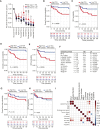High Glucose Contribution to the TCA Cycle Is a Feature of Aggressive Non-Small Cell Lung Cancer in Patients
- PMID: 39960461
- PMCID: PMC11962397
- DOI: 10.1158/2159-8290.CD-23-1319
High Glucose Contribution to the TCA Cycle Is a Feature of Aggressive Non-Small Cell Lung Cancer in Patients
Abstract
Intraoperative 13C-glucose infusions in patients with NSCLC show that tumors with high labeling of TCA cycle intermediates progress rapidly, resulting in metastasis and early death. Blocking this pathway suppresses metastasis of human NSCLC cells in mice.
©2025 The Authors; Published by the American Association for Cancer Research.
Conflict of interest statement
N.G. Hammond reports grants from the NCI during the conduct of the study. R.B. Cameron reports personal fees from MJH Life Sciences outside the submitted work. A. Kaushik reports other support from Pfizer outside the submitted work. A.D. Rao reports other support from MSD outside the submitted work. J.D. Minna reports grants from the NCI during the conduct of the study and personal fees from the NIH and the University of Texas Southwestern Medical Center outside the submitted work. J. Waters reports personal fees from AstraZeneca outside the submitted work, and his wife is a paid consultant for Gore Medical and leads an industry-sponsored clinical trial in peripheral arterial disease. B. Faubert reports grants from the NCI and the Cancer Research Foundation during the conduct of the study. R.J. DeBerardinis reports personal fees from Agios Pharmaceuticals, Atavistik Bio, and Vida Ventures outside the submitted work. No disclosures were reported by the other authors.
Figures






References
-
- Elia I, Doglioni G, Fendt SM. Metabolic hallmarks of metastasis formation. Trends Cell Biol 2018;28:673–84. - PubMed
MeSH terms
Substances
Grants and funding
- UL1 TR001105/TR/NCATS NIH HHS/United States
- Howard Hughes Medical Institute (HHMI)
- P41 EB015908/EB/NIBIB NIH HHS/United States
- R35 CA220449/CA/NCI NIH HHS/United States
- 1P30 CA142543-01/National Cancer Institute (NCI)
- R00 CA237724/CA/NCI NIH HHS/United States
- Nachwuchsgruppenprogramm/Ministry of Culture and Science of the State of North Rhine-Westphalia
- R35CA220449/National Cancer Institute (NCI)
- R01 CA285336/CA/NCI NIH HHS/United States
- 467788900/Deutsche Forschungsgemeinschaft (DFG)
- R01CA285336/National Cancer Institute (NCI)
- T32-009594/National Cancer Institute (NCI)
- P30 CA014599/CA/NCI NIH HHS/United States
- Cancer Research Foundation (CRF)
- R00CA237724/National Cancer Institute (NCI)
- P30 CA142543/CA/NCI NIH HHS/United States
- P50 CA70907/National Cancer Institute (NCI)
- P50 CA070907/CA/NCI NIH HHS/United States
LinkOut - more resources
Full Text Sources
Medical

